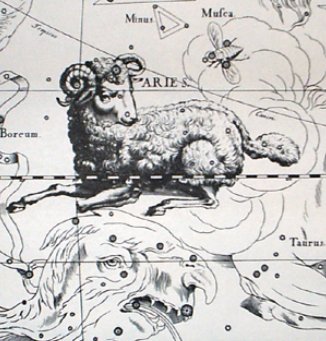Once again. In rongorongo times Hamal (probably
the first of the 10 ariki motogi) -
... Brown
associates it with Aloros, the first of the ten mythical kings
of Akkad anterior to the Deluge, the duration of whose reigns
proportionately coincided with the distances apart of the ten
chief ecliptic stars beginning with Hamal, and he deduces from
this kingly title the Assyrian Ailuv, and hence the
Hebrew Ayil; the other stars corresponding to the other
mythical kings being Alcyone, Aldebaran, Pollux, Regulus, Spica,
Antares, Algenib, Deneb Algedi, and Scheat
...
|
ko oto uta |
ariki motongi |
1 |
|
ko tangaroa.a oto uta |
ariki motongi |
2 |
|
ko tiki hati.a tangaroa |
ariki motongi |
3 |
|
ko roroi.a tiki hati |
ariki motongi |
4 |
|
ko tuu kumā.a roroi |
ariki motongi |
5 |
|
ko ataranga.a tuu kumā |
ariki motongi |
6 |
|
ko harai.a ataranga |
ariki motongi |
7 |
|
ko taana.a harai |
ariki motongi |
8 |
|
ko matua.a taana |
ariki motongi |
9 |
|
ko hotu.a matua |
ariki motongi |
10 |
|
O maori te ariki nei.
etahi te angahuru. ko maori. te ingoa o te kainga.
ko marae renga te ingoa. o te maara noho o te
ariki.nui.ko ma rae tohia te rua maara noho o te
ariki. |
|
Uta
Higher up (from the coast, or from
another place); i uta era, further up, up
there. Vanaga.
1. Inland, landward; paepae ki
uta, to strand, to run aground; mouku uta,
herbage. 2. To carry; uta mai, to import;
hakauta, to give passage. Campbell. |
rose with the Sun in April 20 (*30), but in Roman
times Hamal would have risen 27 days earlier, viz. in 'March 24
(*3) - because at that time Sheratan (The First Point of Aries)
would have been at 0h:

392 (*Ca14-29) - 27 = 365 and the Hamal
year should therefore have begun with glyph number 27:
|
FEBRUARY 15
(46) |
346 |
JANUARY 28
(393) |
61 |
MARCH 31 (28
+ 62) |
APRIL 1 (91) |
13 |
APRIL 15
(105) |
|
MARCH
28 (87) |
MARCH 11 (69) |
MAY 11 (90 + 41) |
12
(132) |
MAY 26
(146) |
 |
 |
 |
 |
 |
|
Ca2-1 (27 =
87 - 60) |
*Ca14-11 (374) |
Cb2-20 (436) |
Cb2-21 |
Cb3-10 (451) |
|
Te heke |
te heke |
ka tuu
te toga o te manu |
kua
tapu - no te manukua tapu - no te manu |
te taketake |
|
April
17 (*27 + 80) |
March 30
(89) |
May 31 (151) |
June 1 (152) |
15 (166) |
|
HAMAL (*30)
MENKENT (*213) |
*377 = *12 +
365
COR CAROLI (*195) |
HAEDUS I
(*74)
*257 |
HAEDUS II
(*75) |
PRAJA-PĀTI, MENKALINAN, MAHASHIM
(*89) *272 |
|
October 17
(290) |
September 29 (272) |
November 30 (334) |
December 1
(75 + 260) |
December 15
(349) |
|
AUGUST 27
(229) |
JULY 30
(211) |
SEPTEMBER 30
(273) |
OCTOBER 1
(274) |
OCTOBER 15
(288) |
|
SEPT
27 (270) |
SEPT 9
(252) |
NOV 10
(314, π) |
NOV 11 (315) |
NOV 25 (329) |
The time when Achernar rose with the Sun at 0h
was 4 precessonal days later than the time of Julius Caesar.
Therefore the stars were 4 steps less ahead in the year compared to
the time when Hamal had been at 0h:
 |
 |
|
Ca1-19 |
Ca1-20 |
| te maitaki
- te kihikihi |
hakaraoa -
te henua |
|
*22
HEZE |
ACHERNAR (*23)
*206 |
Metoro frequently used huki as a
kind of technical term. We can compare with Cb3-1 at heliacal Elnath, *80 -
*24 = 8 weeks later:
|
APRIL 6
(461) |
7 (*17) |
|
MAY 17 (137) |
18
(*58) |
 |
 |
|
Cb3-1
(50) |
Cb3-2
(443) |
| E
vae ra - ka oho - ki te henua -
kua huki |
ku
kikiu - te henua |
|
June 6
(157) |
7 (*81 -
3 + 80) |
|
ELNATH
(*80) |
*81
*264 |
|
December
6 (340) |
7 (*264
- 3 + 80) |
|
OCTOBER
6 (*199) |
7 (280) |
|
NOVEMBER 16 (320) |
17
(*241) |
... Huki á te mahina, said of the new
moon when both its horns have become visible ...
















